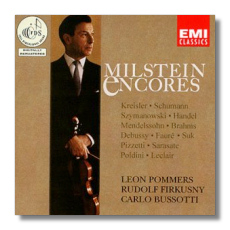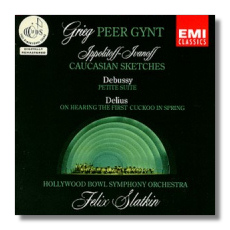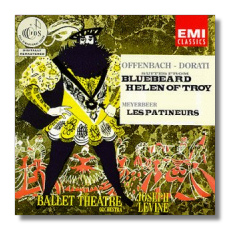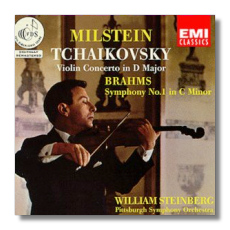
The Internet's Premier Classical Music Source
Related Links
-
Beethoven Reviews
Brahms Reviews
Debussy Reviews
Delius Reviews
Fauré Reviews
Grieg Reviews
Handel Reviews
Ippolitov-Ivanov Reviews
Kreisler Reviews
Léclair Reviews
Mendelssohn Reviews
Meyerbeer Reviews
Offenbach Reviews
Pizzetti Reviews
Sarasate Reviews
Schumann Reviews
Suk Reviews
Szymanowski Reviews
Tchaikovsky Reviews - Latest Reviews
- More Reviews
-
By Composer
-
Collections
DVD & Blu-ray
Books
Concert Reviews
Articles/Interviews
Software
Audio
Search Amazon
Recommended Links
Site News
 CD Review
CD Review
Capitol Full Dimensional Sound

Milstein Encores
- Johannes Brahms:
- Waltz in A Major 1
- Scherzo in C minor "FAE Sonata", WoO 2 2
- Claude Debussy:
- Sonata in G minor 3
- Prélude, Book 1 #12 "Minstrels" 1
- Gabriel Fauré - Après un rêve, Op. 7 #1 1
- Fritz Kreisler
- Praeludium & Allegro in the style of Pugnani 1
- Siciliano & Rigaudon in the style of Francoeur 1
- Ildebrando Pizzetti - Canti #3 Appassionato 1
- Eduard Poldini - Marionettes #2 "Poupée valsante" 1
- Pablo de Sarasate - Introduction & Tarantella, Op. 43 1
- Robert Schumann:
- Piece, Op. 85 #12, "Abendlied" 1
- Sonata "FAE": 2nd mvt, Intermezzo 2
- Josef Suk - Piece, Op. 17 #4 "Burlesca" 3
- Jean Marie Léclair - Sonata for Violin, Op. 5 #10 in C Major Tambourin 1
- Felix Mendelssohn - Songs without Words, Op. 62 #1 "May Breezes" 1
- Karol Szymanowski:
- Nocturne & Tarantella, Op. 28 1
- Myths, Op. 30 #1 "La fontaine d'Aréthuse" 1
- George Frideric Handel - Sonata in B minor, HWV 367b/Op. 1 #9 (Andante) 1
Nathan Milstein, violin
1 Leon Pommers, piano
2 Carlo Bussotti, piano
3 Rudolf Firkušný, piano
EMI Classics CDM66872 ADD Stereo/Mono 75:24


Ludwig van Beethoven
- Symphony #3 "Eroica"
- Symphony #8
Pittsburgh Symphony Orchestra/William Steinberg
EMI Classics CDM67098 ADD Mono 73:59


Slatkin Conducts
- Edvard Grieg: Peer Gynt Suites #1 & 2, Opp. 46 & 55
- Mikhail Ippolitov-Ivanov: Caucasian Sketches - Suite #1
- Claude Debussy: Petite Suite *
- Frederick Delius: On Hearing the First Cuckoo in Spring *
Hollywood Bowl Symphony Orchestra/Felix Slatkin
* Concert Arts Orchestra/Felix Slatkin
EMI Classics CDM67099 Mono ADD 74:15


Ballets
- Offenbach-Doráti: Bluebeard (ballet suite)
- Offenbach-Doráti: La Belle Hélène (Helen of Troy ballet suite)
- Meyerbeer-Lambert: Les Patineurs
Ballet Theatre Orchestra/Joseph Levine
EMI Classics CDM67100 Mono ADD 70:31


More Milstein
- Piotr Ilyitch Tchaikovsky: Violin Concerto, Op. 35
- Johannes Brahms: Symphony #1, Op. 68
Nathan Milstein, violin
Pittsburgh Symphony Orchestra/William Steinberg
EMI Classics CDM67101 ADD 76:18
These five discs are the most recent releases in EMI Classics' series of Capitol Full Dimensional Sound reissues.
One of the strengths of Milstein Encores is that, in spite of its title, it contains quite a bit of music of substance that hasn't been done to death in recital or on disc. For example, we get more than fifteen minutes of Karol Szymanowski: a Nocturne and Tarantella, and The Fountain of Arethuse – lush bits of very late Romanticism that bloom in greenhouse moonlight. Milstein plays them wonderfully. Another more lengthy work is the Debussy sonata, which benefits from Rudolf Firkušný's excellent pianism. More familiar selections by Kreisler (Praeludium and Allegro; Siciliano and Rigaudon, Tambourin), Poldini (Dancing Doll), and others are played with deep attention and a distinctive sense of style. Milstein's tone is almost spreadably rich, and the closeness of the Capitol recordings, made between 1953 and 1960, is like an X-ray. Most of these selections are new to CD; the Debussy sonata is seeing its first release with this disc.
William Steinberg recorded Beethoven's Third and Eighth Symphonies in 1954 and 1955, respectively. Particularly in the Third, he and the Pittsburgh Symphony Orchestra are let down by the boxy recording, which swallows orchestral detail and produces unmusical balances. If you can listen past the sound, however, you can hear that Steinberg's expansive Third is persuasive. As was the case with the Brahms First reviewed above, Steinberg adopts a traditional central European approach. His conducting here is serious and architecturally sound, and only misses the element of joy needed to push this recording into the firmament. Similarly, the first movement of the Eighth could be more friendly, although the rest of the symphony goes well. History has neglected Steinberg. He made some excellent recordings in Pittsburgh and later in Boston, and they show him to be a conductor who was both intelligent and tasteful. His Beethoven Seventh, already released in this series, is excellent, and it is a good place to start if you're curious about his conducting.
For many years, Felix Slatkin was the concertmaster for 20th Century Fox's studio orchestra, and his violinism "appears" in many of that studio's motion pictures from the 40s and 50s. He also formed the Hollywood String Quartet with his wife, cellist Eleanor Aller, and one of their most durable creations was their son, Leonard Slatkin, who of course is in the middle of an international conducting career. Felix Slatkin also founded the Concert Arts Orchestra, which is recorded here in the Debussy and Delius works, and he frequently conducted the Hollywood Bowl Symphony Orchestra. These were professional ensembles in the best sense of the word, as these recordings show. In the early to middle 1950s, when the original LPs were taped for Capitol, orchestras still had individuality. They had faults and virtues, just like the human beings who populated them. No one will mistake either group for the Vienna Philharmonic, yet here were musicians who were used to spending time on film soundtracks, and one feels their quiet pride in stepping into the spotlight here. They knew what they were doing, they did it well, and here was their chance to get more recognition than usual. They failed neither Maestro Slatkin nor the music. Slatkin's conducting is straight-ahead and unexaggerated; these are interpretations that do not call attention to themselves. Perhaps the Grieg is a little plain, but the Debussy and Ippolitov-Ivanov shimmer. The monaural sound is very enjoyable. Perhaps this CD is for collectors like me who tend to have fetishes for old LPs. Certainly there are more modern recordings of all of these works, yet it is fun to get nostalgic over what Slatkin and his musicians did.
Speaking of musicians who might have spent more time in the background than in the foreground, we come to the CD with Joseph Levine and the Ballet Theatre Orchestra. I can't find any information about these musicians, but I believe that they were the "house orchestra" for Ballet Theatre, one of New York City's major repertoire ballet companies. It is unusual for such an ensemble to be heard apart from the visual rhythms of feet hitting the stage, much less on recordings. Levine and the BTO, however, made several Capitol recordings, and this is the third to be released in this FDS reissue series. If you like Gaîté Parisienne, this will surely appeal to you. It is likely that the success of that ballet encouraged other ballet companies to stage their own ballets based on Offenbach potpourris. Ballet Theatre premièred Bluebeard in 1941 in Mexico, and they premièred Helen of Troy in 1949 in Detroit. It would have been helpful if someone had listed precisely where arranger Antál Doráti had taken the music, but it seems that the music is substantially drawn from Offenbach's operettas of the same name (actually, La Belle Hélène, in the latter case). The music from Bluebeard is less memorable, but it zips along with such éclat that this hardly matters. Helen of Troy has the better tunes, and here, listeners will find that Doráti and Manuel Rosenthal (the arranger of Gaîté Parisienne) have used some of the same original material, albeit in different orchestrations. Doráti (and Levine) hardly allow you to catch your breath, so this is bracing – and very enjoyable – listening. According to EMI, these are the only recordings of this music, and this is their first time on CD. Constant Lambert arranged bits of Meyerbeer to create the skating ballet Les Patineurs, which also is chock-full of good tunes. It is surprising how infrequently it has been recorded in the digital era. Levine and the BTO are excellent musicians – few "pit bands" can aspire to this level, and the sound, while dated and a bit cavernous, doesn't stand in the way of enjoyment. (These recordings were made in 1954 and 1956.) Perhaps this CD also is primarily for the nostalgic, but anyone who loves Gaîté Parisienne will want to own this.
Milstein recorded the Tchaikovsky Violin Concerto with William Steinberg and the Pittsburgh Symphony Orchestra in 1959. The interesting thing about their collaboration is the contrast between the plumpness of Milstein's tone and the athletic tautness of the orchestra's. This is not a bad thing in a concerto (to say nothing of a composer) that some people find too gushy. Milstein is less electric than Heifetz, for example, but he plays with the lyrical warmth with which he is associated The middle movement's gentleness is especially gratifying. This is the human side of virtuosity. The Brahms symphony – an odd coupling for Tchaikovsky – was recorded three years earlier. There is no nonsense to Steinberg's interpretation. He was comfortable with Beethoven and Brahms, and this Brahms First is solid, unexaggerated, and faithful to the score. It's like good German bread – it isn't wonderfully imaginative, but it is nourishing and satisfying. The recording, again close and somewhat dry, emphasizes the fibre of the Pittsburgh strings, as well as the first-chair hornist's saxophone-like tone.
Copyright © 2000, Raymond Tuttle



















